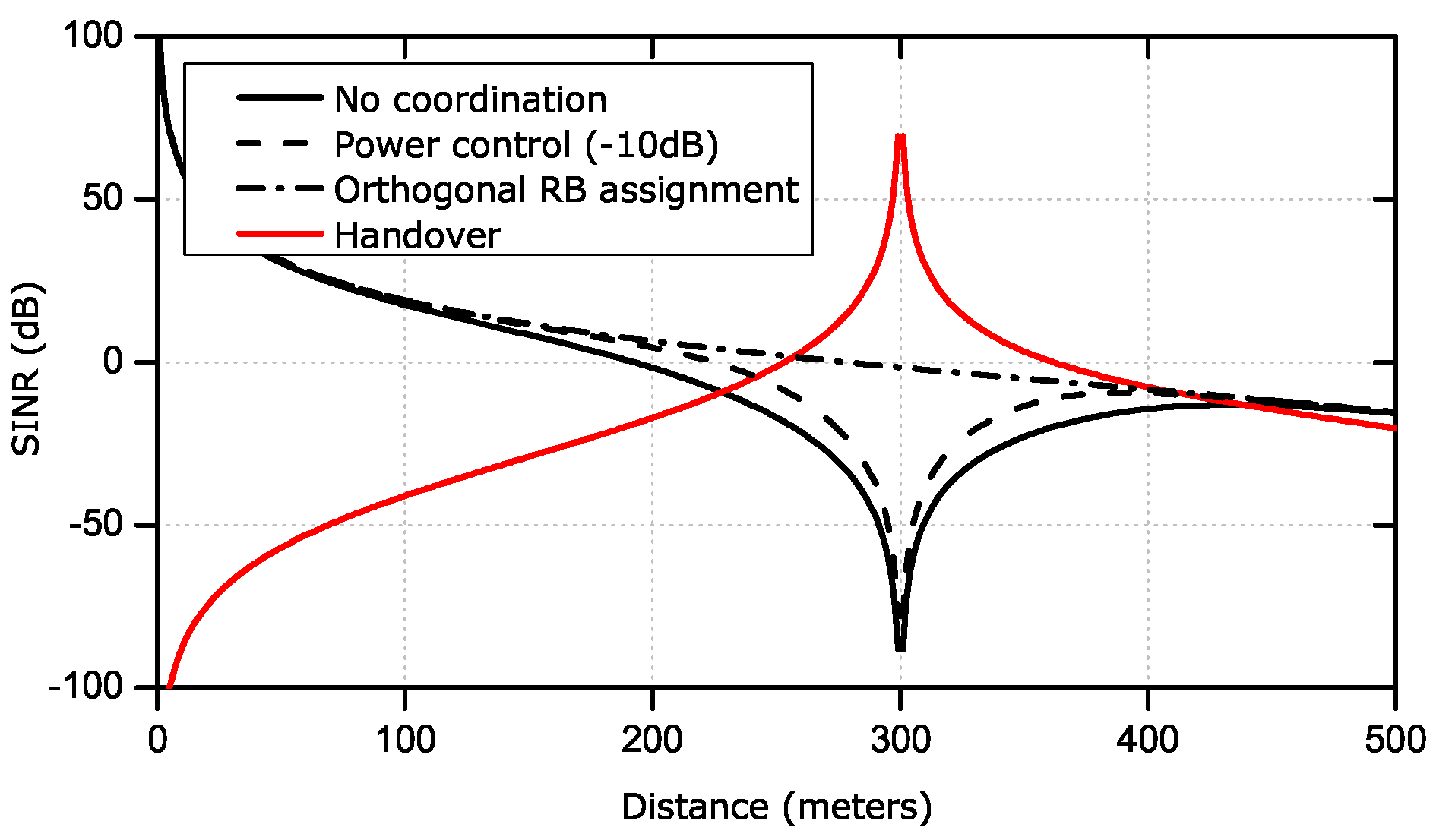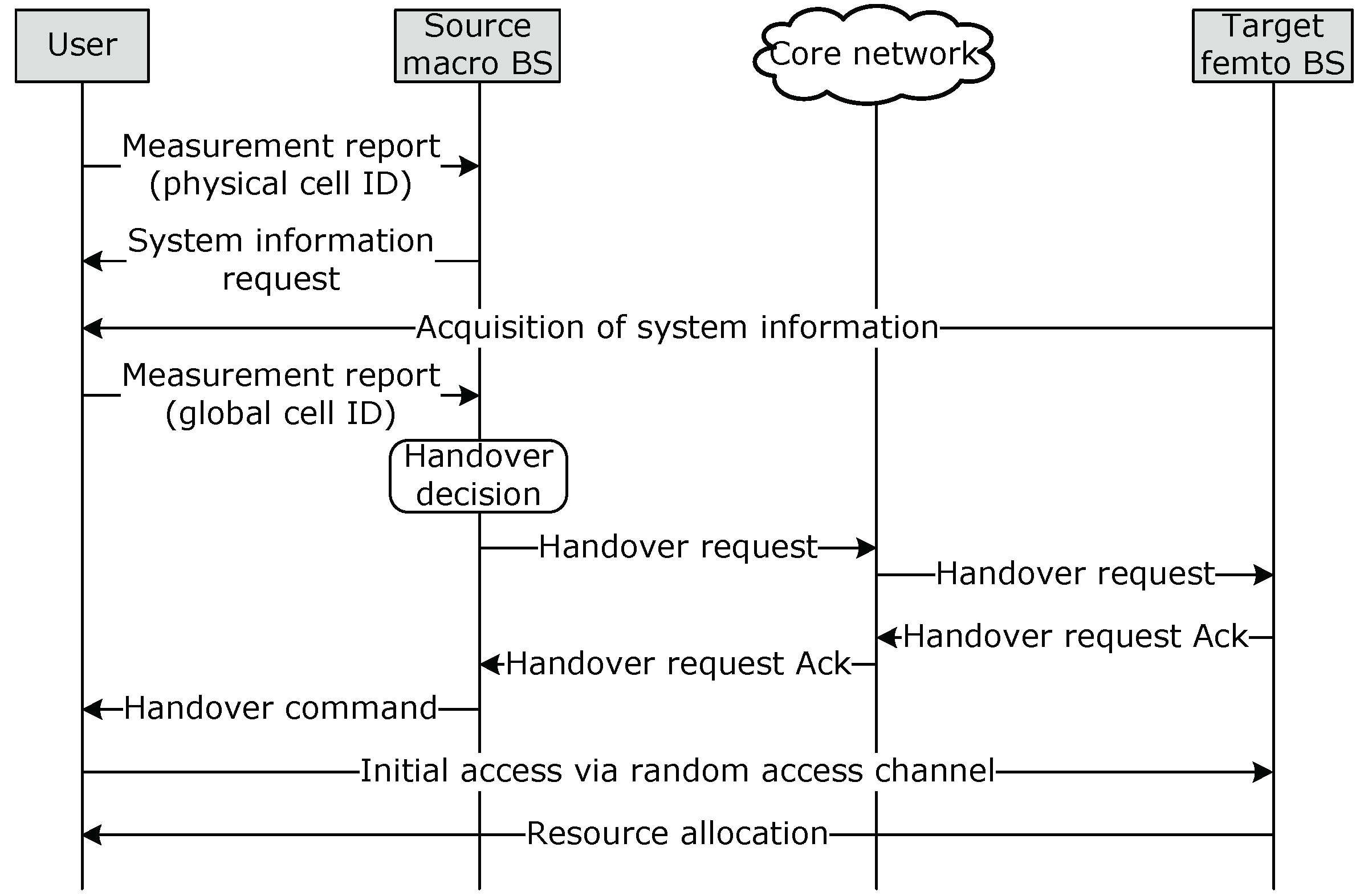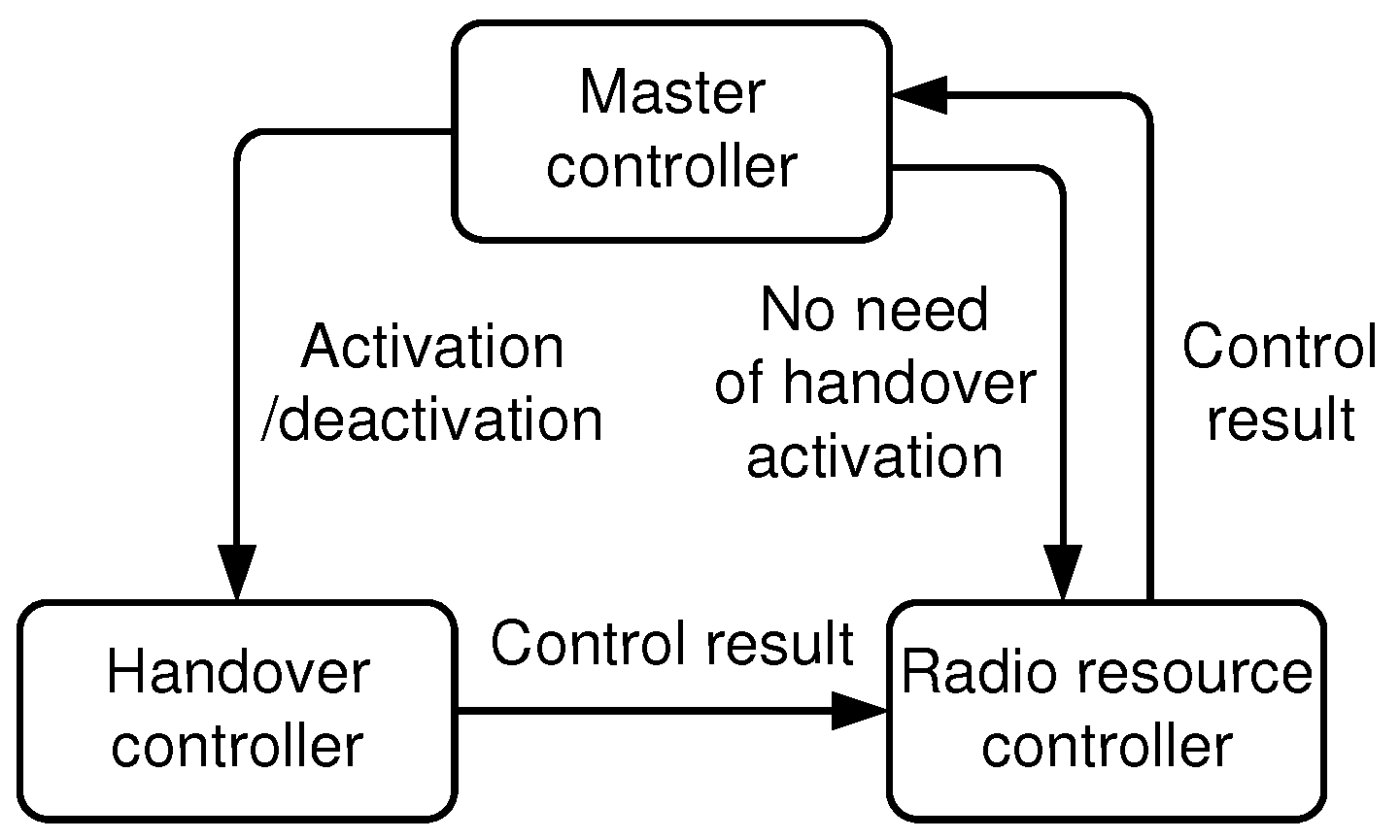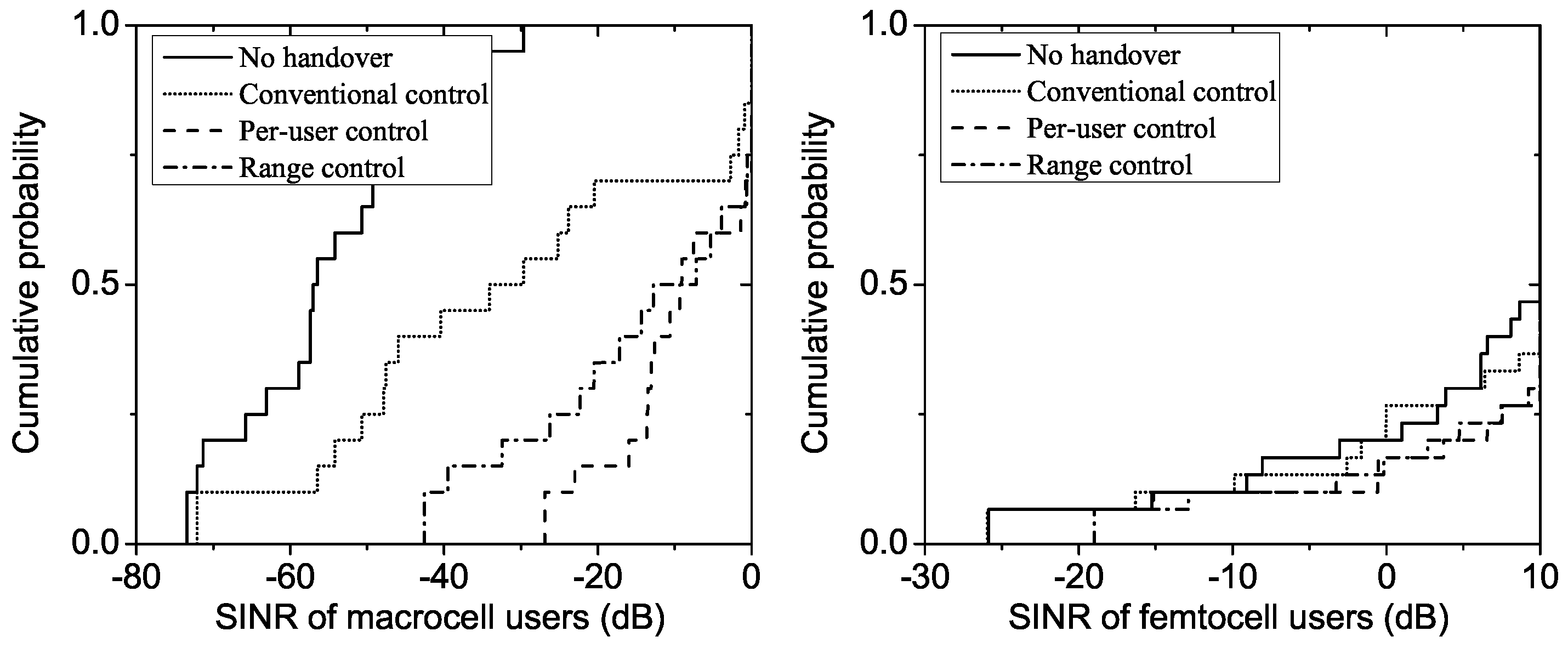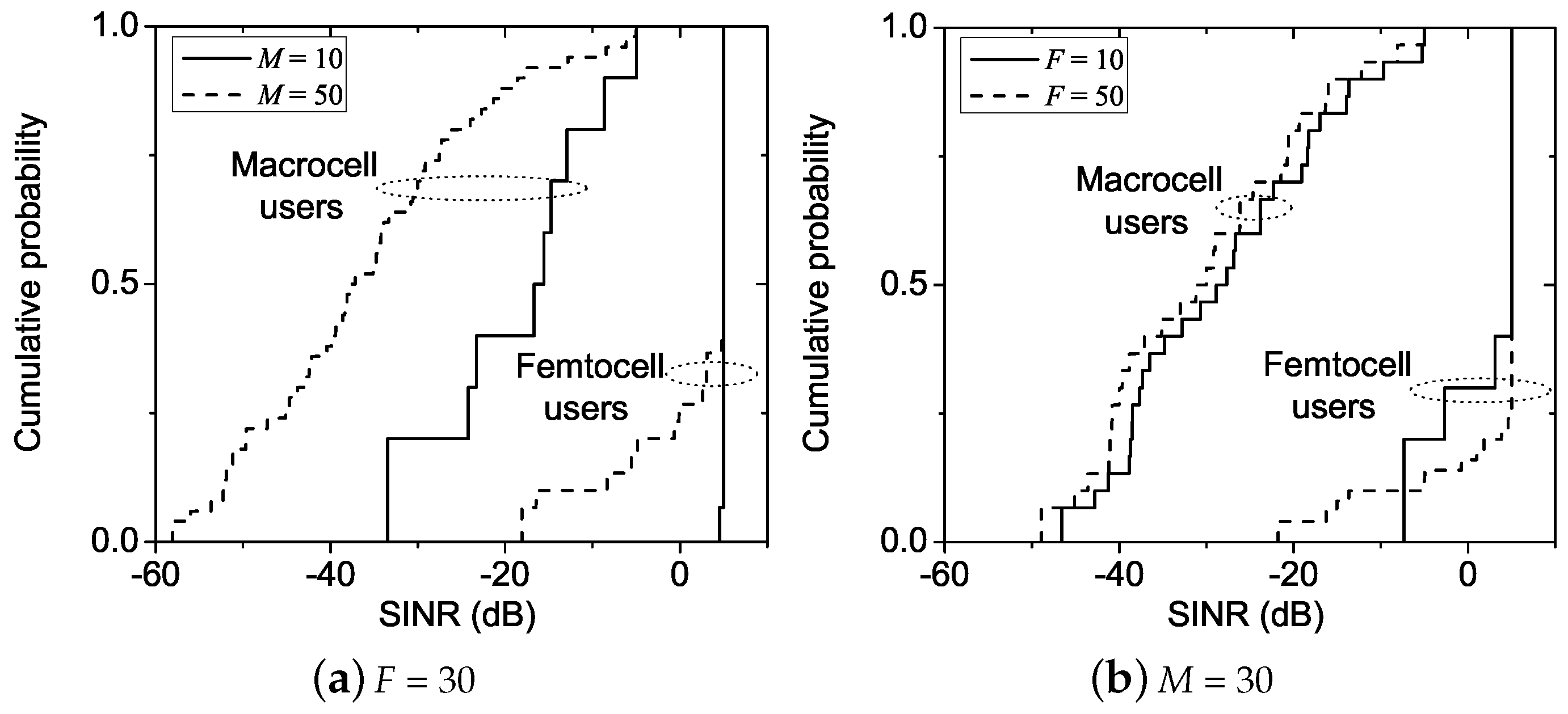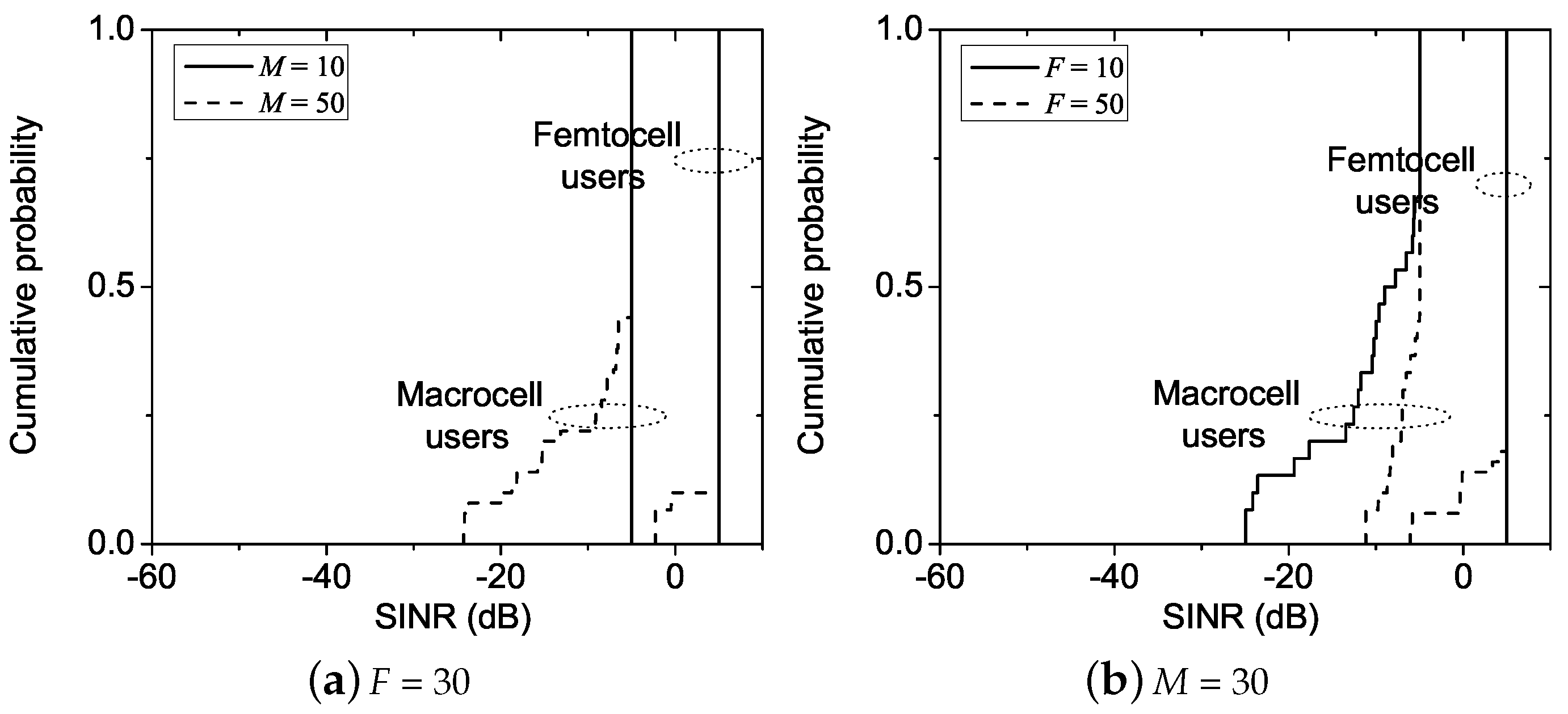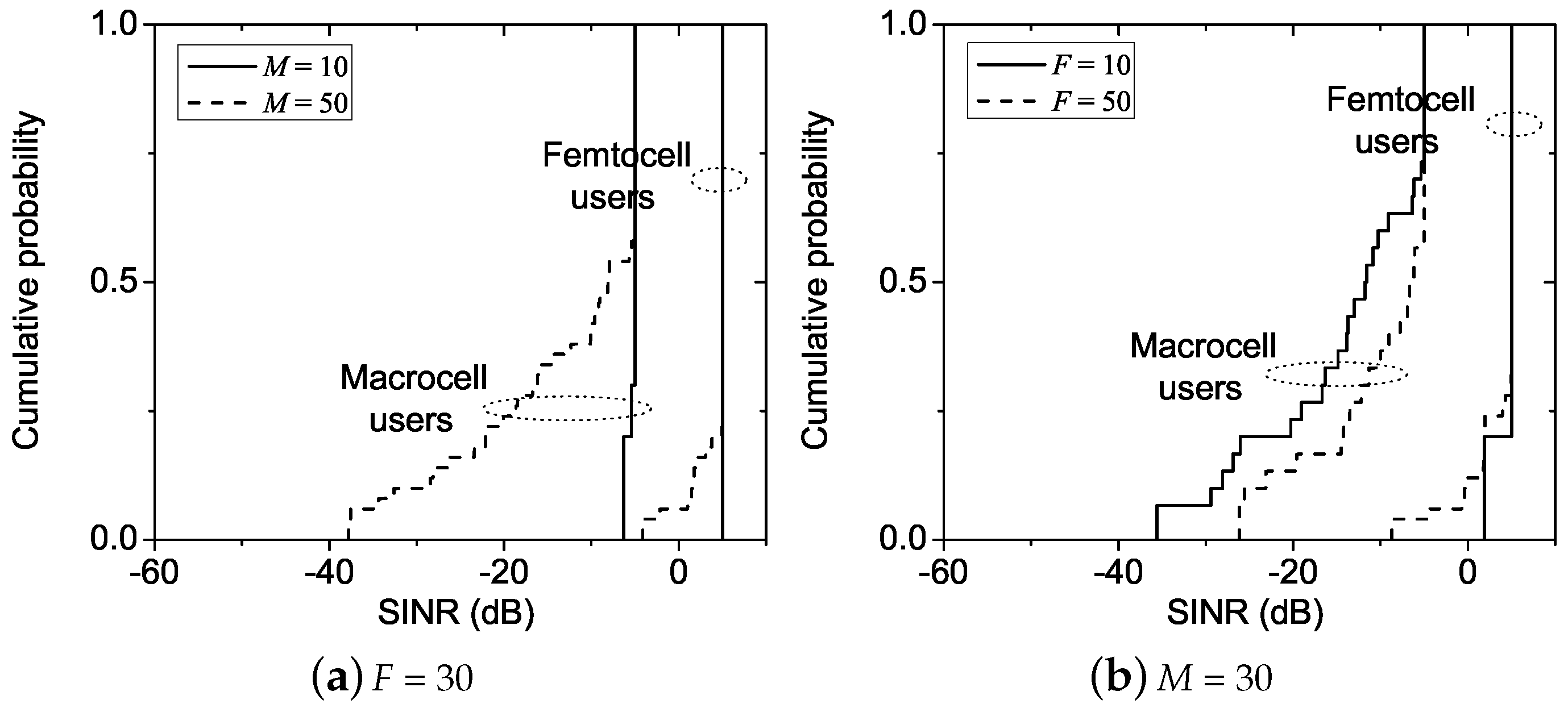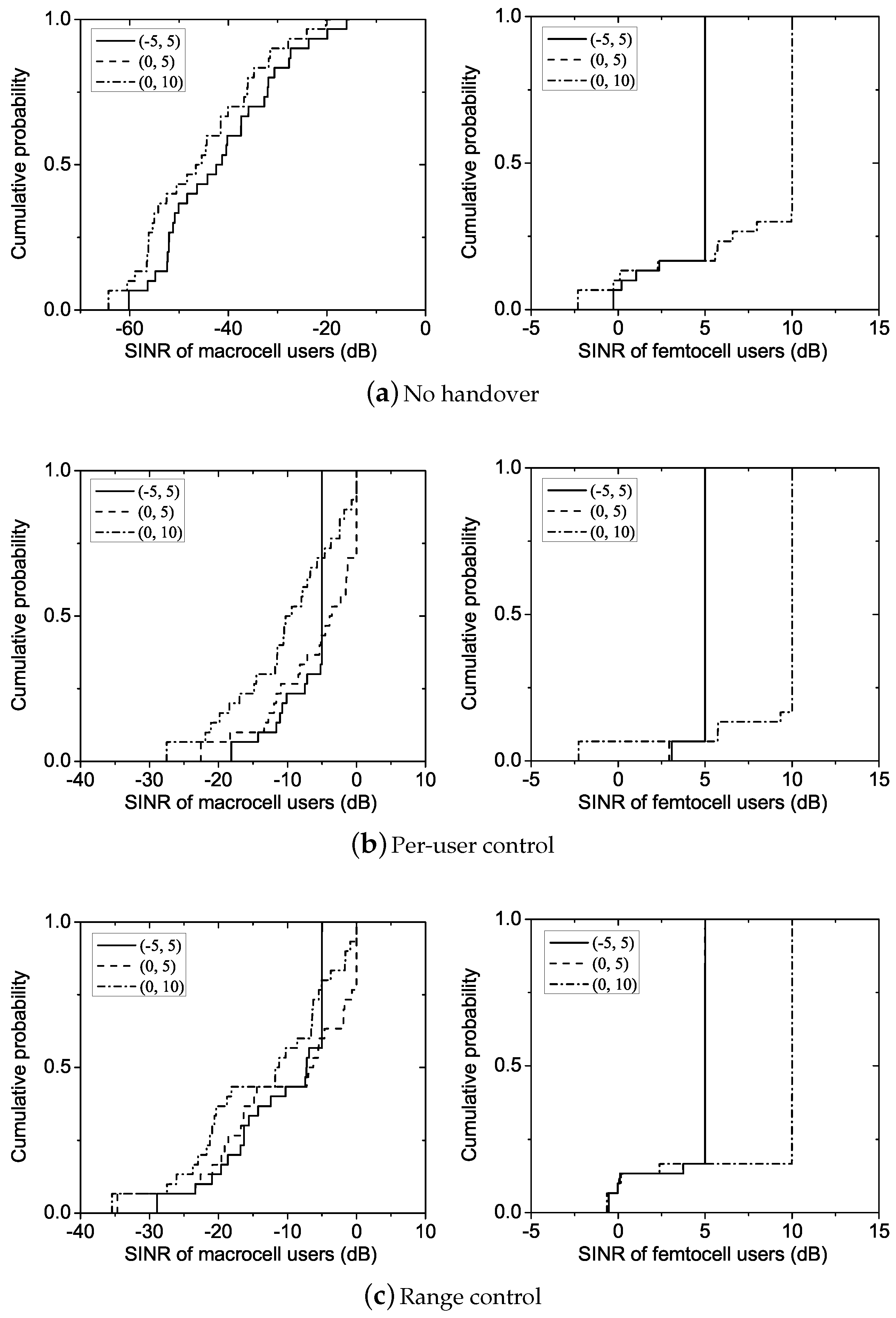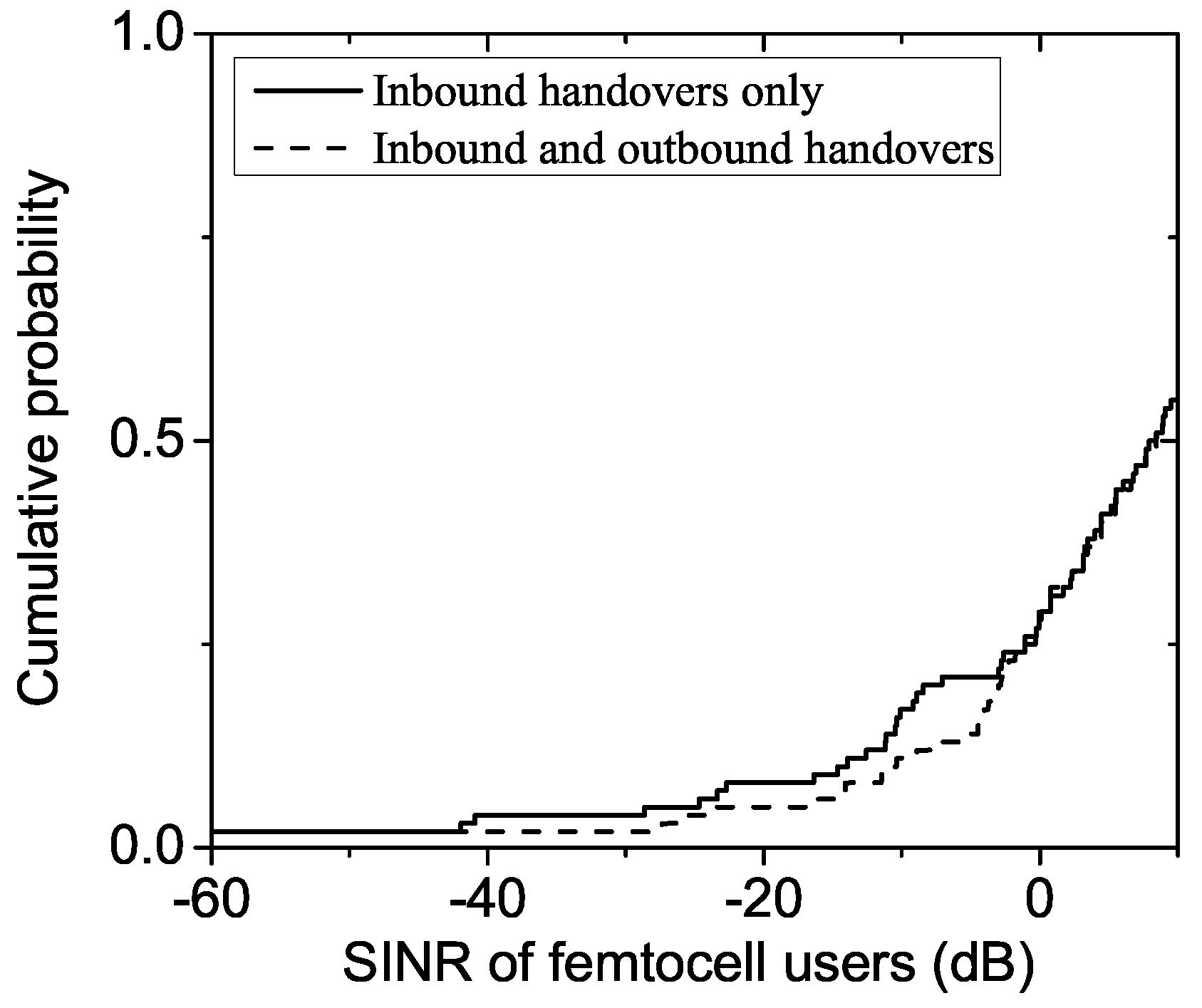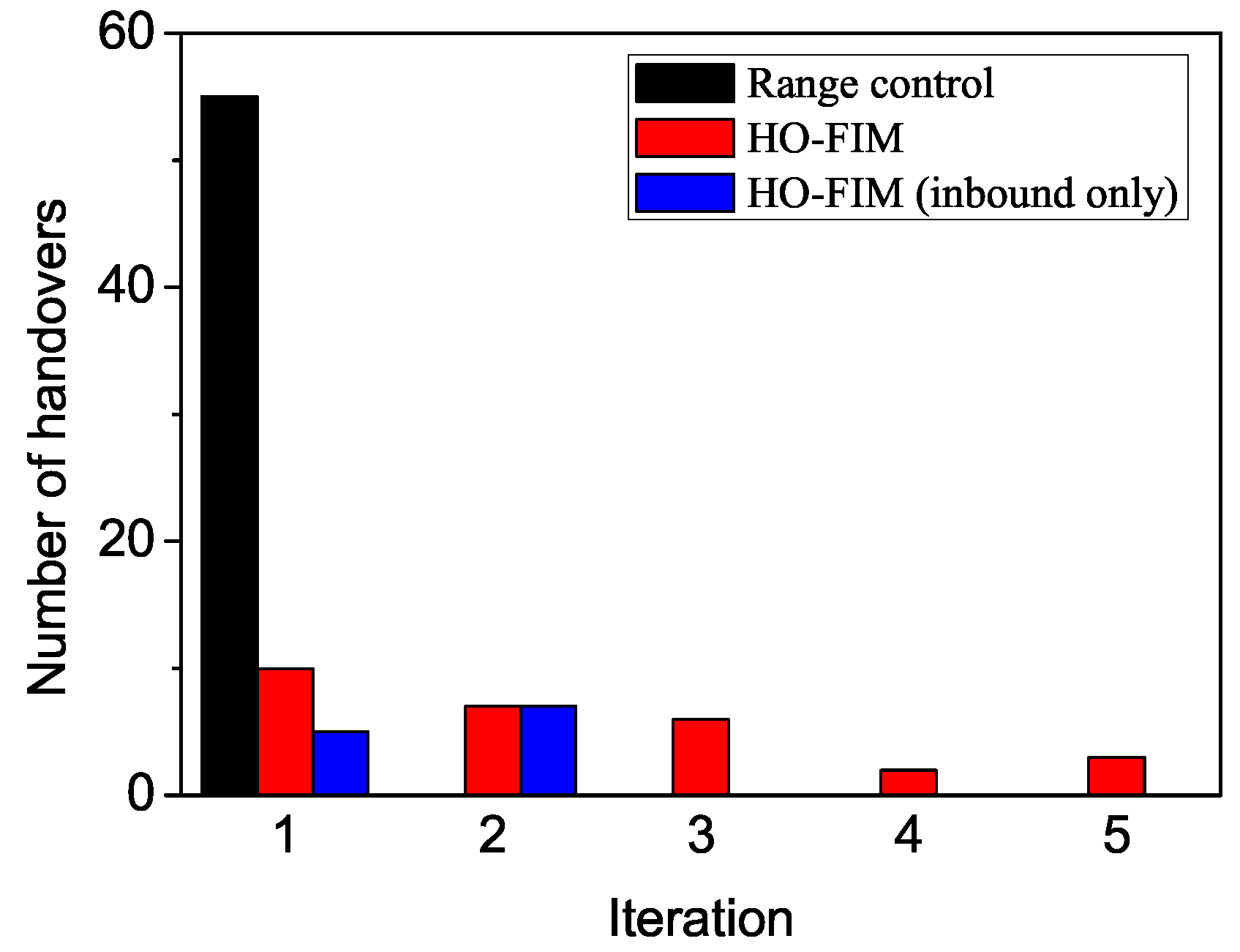1. Introduction
Recently, there has been a growing interest in femtocell technology, which promises cost-effective enhancement of indoor network coverage and capacity to meet increasing demands for bandwidth-hungry data services within home or enterprise environments [
1]. A femtocell is a small indoor area covered by a low-power base station (BS), referred to as a
femto BS in this paper. A significant capacity improvement is expected to be achieved with femtocells via their enhanced spatial reuse of spectrum resources. In addition, femtocells can offload macrocells and improve indoor coverage at low capital and operational costs. Femto BSs are installed on the subscriber’s premise without the operator’s lengthy planning and are typically connected to an operator’s core network via public Internet connections, such as DSL and cable modems.
A key challenge faced by femtocell technology is how to protect macrocell user services from femtocell interference when macro- and femtocells are allocated the same frequency band for economic reasons, called
co-channel deployment, while exploiting spatial reuse of channel resources within femtocells. Co-channel deployment of macro- and femtocells is expected to be commonplace due to the high cost of the licensed spectrum. Under this co-channel deployment, transmissions within femtocells may cause harmful interference to user services within macrocells, and vice versa, as reported by many researchers [
2]. The resultant performance degradation has become a major obstacle to market penetration of the femtocell technology, since the deteriorated service to existing users will increase the churn rate.
There have been many proposals to resolve the femtocell interference problem based mostly on radio resource coordination between macro- and femtocells, but their achievable capacity is limited. To overcome the capacity limit of existing approaches by adding a degree-of-freedom (DoF) when solving the interference problem, a new solution architecture called HandOver-driven Femtocell Interference Management (HO-FIM) is proposed. HO-FIM mitigates the interference problem and offloads the overall heterogeneous networks by exploiting handovers between macrocells and hybrid-access femtocells based on the users’ measurement reports. A new challenge associated with this approach is how to minimize the number of triggered handovers and suppress ping-pong handovers while reaching a desired system condition, since handovers accompany inevitable interruptions of ongoing user services being handed over. This paper proposes to meet this challenge by triggering handovers only when absolutely needed and, once triggered, to find an optimal handover sequence to reach a target system condition with minimal handovers. HO-FIM accompanies a greedy per-user control algorithm which has a fine control granularity and thus enables convergence to an optimal solution. HO-FIM is composed of the following three interacting controllers:
Master controller: Makes decisions on whether to activate/deactivate the handover controller based on the current status of radio resource usage;
Handover controller: Determines a sequence of handovers to be made to reach a target system condition with minimal handovers while avoiding ping-pong handovers;
Radio resource controller: Handles intra-cell scheduling of frequency, time and power resources to meet users’ target service levels.
The approach of HO-FIM is also applicable to the general concept of heterogeneous networks (HetNets) that represents cellular deployments with heterogeneous types of cells of different sizes and overlapping coverage areas including femto and small (hotzone) cells.
The evaluation results show that HO-FIM improves the performance of both macro- and femtocell users under various environmental settings. In an example scenario with 30 macrocell users and 50 femtocell users within a macrocell, more than 90% of macrocell users achieved higher signal-to-interference and noise ratios (SINRs) by 23.3 dB on average than in a case without using handovers; the entire cohort of femtocell users achieved 2.9 dB higher SINRs.
The rest of this paper is organized as follows.
Section 2 and
Section 3 describe the motivation of this work and the system model, respectively.
Section 4 presents the HO-FIM architecture, and
Section 5 describes the control algorithm.
Section 6 evaluates the HO-FIM architecture using detailed simulations, and
Section 7 concludes the paper.
2. Motivation
The use of handovers for interference mitigation is first advocated. Then, the requirements of a new interference management architecture is discussed and the limitations in applying existing techniques to femtocell networks is identified.
2.1. Why Handover for Interference Mitigation?
A main challenge associated with femtocell technology is how to protect macrocell user services against femtocell users’ interference when macro- and femtocells use the same frequency band, while exploiting high spatial reuse of spectrum resources within each femtocell. Due to the high cost of the licensed spectrum, operators may wish to allocate both macro- and femtocells the same frequency channel, called co-channel deployment. Under this co-channel deployment, however, transmissions of femtocell users (those being served by femtocells) may cause interference to the ongoing transmissions of macrocell users (those being served by macrocells), and vice versa, in both downlink (DL) and uplink (UL) communications.
As briefly reviewed below in this section, there have been numerous research efforts to tackle this problem based on radio resource coordination; these approaches can be classified into orthogonal
resource block (RB) assignment (a resource block (RB) is a group of subcarriers and also the minimum scheduling granule in OFDMA systems; for example, in 3GPP Long-Term Evolution (LTE), 12 contiguous subcarriers compose an RB (5 RBs in a 900 kHz band)), power control or combinations thereof.
Figure 1 compares the achieved DL SINR of a macrocell user under different approaches, showing that radio resource coordination can mitigate the interference problem to some degree. As a macrocell user passes by a femto BS located 300 m away, his SINR gets deteriorated considerably. To protect the nearby macrocell users’ communications, the femto BS can reduce its transmitting power (power control) or use a different RB from that allocated to the macrocell user (orthogonal RB assignment). However, both approaches, if operated dynamically, require the detailed (e.g., per-RB) and real-time information of the macrocell’s resource usage, and, moreover, their achievable gain is limited.
Another solution that can be combined with radio resource coordination is to hand the macrocell user over to the interfering femtocell if the femtocell has spare resources to serve the user.
Figure 1 shows that the handover approach can not only mitigate the interference problem but also improve the achievable capacity significantly. The performance gain of the handover approach comes from: (1) reduced interference (due to reduced path losses and enabled coordination within the same serving cell); and (2) load-balancing, as explained next. A macrocell user may experience high DL interference from, and produce high UL interference to, a nearby femtocell. If the macrocell user is handed over to the femtocell, he may experience reduced loss of paths to his serving cell (i.e., the femtocell), thus achieving a better SINR with the same radio resources or a target SINR with less radio resources. Moreover, both macro- and femtocell users—previously interfered with by each other—will be served by the same femtocell with their interference coordination enabled. In many cases, femtocells are also likely to be less loaded than macrocells, as they typically serve fewer users. Thus, a macrocell user, if handed over to a femtocell, will likely be allocated more radio resources. However, the standard handover decisions based on the strongest signal power are not suitable for realizing the above benefits, since, due to the overlaid cell deployment, a macrocell’s signal strength could still be strong within a femtocell’s coverage area. Therefore, the handover-based approach requires a new method of making handover decisions, tailored to femtocell networks. It should determine which user should be handed over to which femtocell and when.
Handovers from macrocells to femtocells may not always be supported due to the different access modes of target femtocells:
Open Subscriber Group (OSG) femtocells, where all users are allowed to connect;
Closed Subscriber Group (CSG) femtocells, where only subscribed users are allowed to establish connections; and
Hybrid-access femtocells: Unsubscribed users are allowed to access if there are idle/spare resources.
In general, a femtocell can support only a small number of concurrent sessions (e.g., eight or eight data sessions) due to its limited processing power. Thus, private femtocells are likely to operate in the CSG mode, although OSG mode may provide a higher capacity if interference is mitigated. Therefore, a hybrid of the two access modes may maximize capacity while preserving the privileged access of subscribed users. Thus, the use of hybrid access for all femtocells is assumed.
2.2. Requirements of a New Architecture
Due to the use of handovers and other salient features of femtocells, the following requirements have to be considered when designing a handover-based interference management architecture.
Minimization of handovers: Current OFDMA-based cellular systems (e.g., 3GPP LTE and 5G NR) support hard handovers only. Thus, a user’s handover accompanies a temporary interruption of his ongoing voice or data service as well as a signaling overhead. To minimize users’ performance degradation, handovers should be triggered only when service deterioration for users would otherwise be inevitable or if a significant reduction of the interference to macro- and femtocell users is expected. Moreover, any solution algorithm should be able to reach a desired system condition with the minimum number of handovers. Ping-pong handovers must be avoided as well.
Low computation complexity: This is an important design requirement due to the expected large number of users to be supported by a single BS in forthcoming cellular networks (resulting from the increased bandwidth) and multiple femtocells to be deployed within a macrocell. The Next Generation Mobile Networks (NGMN), an alliance of cellular operators, specifies that a 5G network should support up to 150 thousand concurrent user sessions per square kilometer [
3]. To meet such a high connection density, the number of femtocells to be installed within a macrocell coverage area could be up to several thousands in the future. Consequently, the search space of a handover-decision algorithm will be widened significantly.
No special hardware: For cost-efficiency, femto BSs and user devices should not be required to have special hardware.
2.3. Limitations of Existing Techniques
There is a rich body of research that has attempted to resolve the femtocell interference problem based on radio resource (power, frequency, and time) management. Ma et al. [
4] proposed a hybrid overlay and underlay spectrum access mechanism and solved a subchannel allocation problem as a coalition formation game among femtocell users. Yun et al. [
5] proposed an asynchronous coordination scheme of co-channel femtocells based on delayed signaling and asynchronous update behavior and derived the condition of configuration parameters that guarantees convergence to a global optimum. DACA [
6] is an intra- and inter-cell resource coordination framework associated with control algorithms for full-duplex heterogeneous cellular networks.
Recently, there have been an increasing number of proposals exploiting hybrid-access femtocells. AbdelNabi et al. [
7] analyzed the performance of hybrid access schemes in the perspective of MIMO array configurations. Kim et al. [
8] proposed a scheme to jointly optimize the ratio of dedicated resources for femtocells in open and hybrid-access femtocells. Zhang et al. [
9] proposed a spectrum allocation method for hybrid-access femtocells where a macro BS allocates a portion of subchannels to femtocells with which each femtocell guarantees the throughput of served macrocell users. Deng et al. [
10] proposed a similar framework and designed an auction-based algorithm where each femtocell receives additional macro users as bidders while the macro BS acts as the auctioneer. Thakur et al. [
11] developed a QoS-aware cell selection scheme that assigns mobile users to femtocells, incorporating the energy consumption of backhaul links. Game-theoretic incentive frameworks to motivate femtocells to adopt a hybrid access policy by pricing accessed macrocell users’ resource usages were proposed in [
12,
13]. However, most studies focused on intra-cell resource management combined with BS assignment, and none considered the optimality and convergence of dynamic handover management.
Some research works focused on the cell selection problem (also known as the BS assignment problem) that is used to find optimal pairs of users and serving cells. The system energy efficiency of small cell networks was considered for cell selection in [
14,
15]. There are numerous proposals to solve the problem in general cellular networks. Yates and Huang [
16] proposed synchronous and asynchronous distributed algorithms that find the optimal power vector and BS assignment. Lee et al. [
17] developed a pricing-based BS assignment algorithm considering the congestion level of BSs. The use of iterative algorithms based on linear programming (LP) to solve the BS assignment problem was presented in [
18]. Alorainy and Hossain [
19] considered a coordinated multipoint dynamic cell selection problem. However, they all focused on the optimality of resultant BS assignments only, and none of them considered the handover overhead. Some heuristic approaches that consider the handover overhead exist, but they do not guarantee the optimality [
20].
Range extension, which expands the handover ranges of overlaid cells [
21], was discussed in 3GPP as a solution to address the interference problem. The use of cell ranges for distributing users is advantageous in that it can be implemented within a conventional cell-selection framework of existing cellular systems without modifying user devices or an air interface. To fully realize the benefit of the range extension, vendors need an algorithm to control the handover ranges. There has been a notable attempt at optimal range control for hybrid-access femtocells. ARCHoN [
22] allocates radio resources (frequency, time, and power) and distributes/assigns users among overlapping cells by controlling hotzone cell ranges such that the overall DL and UL loads of a HetNet are minimized while per-user rate constraints are met. The proposed scheme of this paper outperforms ARCHoN due to its finer control granularity (as compared in the evaluation section).
4. The HO-FIM Architecture
The architecture of HO-FIM and its basic concept and design rationale are presented first. Then, the problems for the design of a control algorithm for the HO-FIM architecture are formulated.
4.1. Overview of HO-FIM
The objective of HO-FIM is to offload both DLs and ULs to mitigate the interference between macro- and femtocells while preserving the users’ quality of service (a load is defined in the next subsection). To meet this objective, HO-FIM hands over users dynamically between macro- and femtocells. Basically, HO-FIM is required to make the following important decisions:
when to trigger handovers;
which macrocell users to be handed over; and
which femtocell to hand a selected user over to.
Besides, HO-FIM needs to minimize the number of triggered handovers and suppress ping-pong handovers while reaching a desired system condition. HO-FIM is composed of three interacting decision-making controllers, as illustrated in
Figure 3. In what follows, each of these controllers and their complementary interactions are described.
4.1.1. Master Controller
The master controller decides to activate the handover controller only when needed to minimize handovers; a decision is made based on the current status of radio resource usage reported by the radio resource controller, i.e., when a macrocell’s load exceeds a certain threshold (activation threshold). The master controller stops the handover controller running if the network load status gets: (1) close enough to an optimum; or (2) lower than a certain point (deactivation threshold). The latter will go through fewer handovers.
4.1.2. Handover Controller
The handover controller, once activated, finds a handover sequence to reach a target system condition with minimal handovers. The past handover history also needs to be taken into account for a user not to suffer from repeated (or ping-pong) handovers; once a user is handed over, he will not be considered again as a candidate for handover for a certain duration. The algorithm designed for the handover controller’s decision determines handovers iteratively in a greedy manner.
4.1.3. Radio Resource Controller
This controller schedules the frequency and handles time and power resources to meet the users’ target SINRs. It is assumed that the allocation of frequency (resource block, RB) and time resources is done by conventional schedulers. It is also assumed that the target SINR of a user is given on a per-RB basis. Transmit power is controlled to meet the per-RB target SINR.
4.2. Definition of Cell and System Loads
The load to measure the degree of crowdedness of a cell or the entire system is defined. It is assumed that the power resource allocated to a user at a RB is zero unless the RB is assigned to him. Then, the load can be modeled as a function of allocated power as follows:
Load of cell i measures the resource usage status of cell i. It depends on the power allocations of the users being served by cell i.
System load measures the resource usage status of all users in the entire system. It depends on the power allocations of all users.
The macrocell load is denoted by and the activation and deactivation thresholds of the handover controller are denoted by and , respectively.
Two properties of the load function are assumed: (1) the cell and system loads are monotonically increasing in the transmit power vector; and (2) the cell load function is additive, i.e., when is the transmit power vector assigned to user j. The monotonicity is straightforward. The additivity is acceptable if the cell load is defined as a sum or an average of the per-RB load since RB assignments are orthogonal between users within a cell ().
4.3. Problem Formulation
To simplify the exposition, a single RB is assumed while formulating problems and describing algorithms. Extension to multiple RBs is straightforward.
Let be the serving cell of user j and and be the DL transmitting power to, and the UL transmitting power from, user j, respectively. is the minimum target SINR. For the user set , the following vectors are defined:
Serving cell vector
DL transmit power vector
UL transmit power vector and
Minimum target SINR vector
Then, HO-FIM aims to find (by the handover controller), , and (by the radio resource controller) that minimize the DL and UL loads of the entire network. The handover-based load minimization problem denoted by is stated as (the curled inequality symbol ⪰ (and its strict form ≻) represents component-wise inequality):
Definition 1 (Handover-based load minimization problem).
When solving , and are given by the radio resource controller. It is said that is feasible when a SINR higher than is achieved, i.e., where is a DL channel gain and is the DL interference experienced by user j; is feasible when is feasible for all . The feasibility of and is defined likewise. The feasibility conditions of and can be written using matrix notation as and , respectively, when the elements of the normalized channel gain matrices and are defined as or and or . is the thermal noise.
The handover overhead is considered in a separate problem. Let and denote the initial and limit points of the serving cell assignment, respectively. Let be a handover sequence to reach from and be the load update step of a macrocell at the tth iteration when is applied. Then, to minimize the number of handovers: (1) should be minimized when is the number of triggered handovers at the tth iteration and T is the number of iterations required to reach ; and (2) the gap between and should be minimized as well. Thus, the handover minimization problem can be defined as follows:
Definition 2 (Handover minimization problem).
5. Control Algorithm
A handover control algorithm to solve and is now presented. The proposed algorithm operates in a greedy manner, i.e., it makes a decision at each iteration without considering achievable gains at subsequent iterations. This greedy strategy enables the design of a simple algorithm and the analysis of its convergence behavior. The pseudo code of the algorithm is given in Algorithm 1.
| Algorithm 1 Handover control algorithm. |
- 1:
t : Slot index - 2:
: Interval of handover-controller activation (in terms of slots) - 3:
: User set to be handed over in the current iteration - 4:
: Maximum allowed number of handovers per iteration - 5:
for slot t do - 6:
Update radio resource allocation for all user - 7:
if then - 8:
- 9:
- 10:
for do - 11:
Obtain according to Equation (12) - 12:
if then - 13:
- 14:
end if - 15:
- 16:
- 17:
end for - 18:
Perform handover for all user - 19:
end if - 20:
- 21:
end for
|
For a greedy algorithm to reduce the number of handovers, it is beneficial to trigger more gainful handovers at each iteration than those of other sequences as well as those at subsequent iterations. That is, it chooses such that: (1) for any feasible sequence ; and (2) . The rationale behind this strategy is as follows: First, consider two sequences and such that . Then, it is probable that, for arbitrary , does not reach at the tth iteration while does. Second, suppose that and . Similarly, for arbitrary , is likely to reach earlier than . Note that these conditions are meaningful because a greedy algorithm is assumed (there could be a sequence requiring less handovers while not meeting these conditions). An algorithm called per-user control is designed so as to meet the above conditions.
The handover of multiple users or only one user may be allowed at each iteration. The former will speed up convergence at the expense of more handovers than the latter due to the coarser control granularity. It is shown that both converge to a unique optimal assignment .
At each iteration, a macrocell first calculates the expected transmit power of its users when each of them is handed over to a candidate target femtocell while keeping the others in the macrocell. When user
is handed over to femtocell
, his minimum transmit power needed to meet the target SINR
within cell
n, denoted by
and
for DL and UL, respectively, is obtained as
where
and
are the average levels of DL and UL interference experienced by user
j at a RB after user
j is handed over to cell
n. It is expected in general that the path loss of a user to a femtocell is smaller than that to a macrocell, so there may exist femtocell
n enabling user
j to have lower
and
than those with the macrocell, thus leading to reduced interference. This is one reason why the handover approach achieves enhanced performance. After this handover, for downlink (uplink), the macrocell (other macrocell users) becomes a new interference source while femtocell
n (its users) no longer causes interference due to the orthogonal RB allocation within the cell. Let the expected DL interference from the source cell (macrocell
m) after the handover be denoted by
and that from the target femtocell
n before the handover be denoted by
. That is, by the handover, the new interference term
is added to and the existing term
is removed from the total DL interference experienced by user
j, which can be interpreted as load adjustment (load-balancing) between the cells. If femtocell
n is selected such that
, i.e., appropriate load-balancing is applied, the resulting DL interference experienced by user
j is reduced, which is another reason why the handover approach obtains performance gain. Assume that the long-term probabilities for a user to be allocated each RB are evenly distributed. Then,
is rewritten as
where
m indicates the source macrocell. If cell
n broadcasts
(the average per-RB DL transmit power) in SI, the macrocell can obtain the information by commanding users to report it. Similarly, it is also assumed that
is broadcast by cell
n and reported by users to the macrocell. Thus, the macrocell has all the information required to calculate
and
. Using this calculation result, the transmit-power vectors are defined as
and
.
Next, the macrocell determines the target femtocell of user
j such that a maximum decrease of its cell load is obtained at this iteration. This is expressed as
where
The above problem should be solved for each user. Thus, the search space size of the per-user handover control problem is
. Finally, the serving cells and transmit powers at
are determined as
If the determined serving cell of a user differs from the current one, his transfer will be triggered. Here, only inbound (from macrocell to femtocell) handovers are considered, and, thus, femtocell users stay within their serving femtocells while their power allocations are updated. When outbound (from femtocell to macro- or other femtocell) handovers are allowed as well, femtocells make handover decisions on their users in the same way as the macrocell does. It is now shown that the above algorithm converges to an optimum.
Proposition 1. A unique system load exists such that for .
Proof. Due to the monotonicity of
in
, a sufficient condition is the existence of a unique power vector
such that
, i.e.,
. When DL was considered only, the existence and uniqueness of
were proved in Theorem 1 of [
16] under the same feasibility condition as defined earlier on
. A new power vector
can be defined and then the actual problem is transformed into one with an analogous structure to the DL-only problem. Thus, the above proposition follows. □
Proposition 2. Starting from any feasible power vectors and , the per-user control algorithm makes the system load ρ converge to .
Proof. The proof follows a procedure similar to the one used in [
16]. Consider a condition where, if
and
are feasible power vectors,
, and
and
are feasible. If this condition is met,
, and
and
are feasible. Hence, the sequence of
is decreasing and always feasible. Since
is monotonic and bounded below by
, the sequence of
converges to
.
In what follows, it is shown that the proposed algorithm meets the above condition. Equation (6) can be rewritten as
where the second equality follows from the additivity of the cell load function. That is, the algorithm minimizes
Therefore,
where the last inequality is obtained by the defined monotonicity of the cell load function and the assumed feasibility of
. Equation (9) shows that the cell load decreases monotonically as the algorithm runs through iterations. If
is feasible,
since
, thus
is also feasible and the same holds for
(
is
jth row vector of
). Thus, the above condition is met. □
Proposition 3. The load gap monotonically decreases as the algorithm runs through iterations.
Proof. First, a power gap is defined as
It has been shown for fixed
that, if the largest eigenvalue of
is less than unity, the power update procedure converges at a geometric rate [
25]. Therefore,
is a monotonically increasing function in
. Similarly, so is
. Let
be the BS assignment at
t, then
where the first inequality follows from the monotonicity of
and
. From Equation (6),
for all
, and, thus, Equation (11) is non-negative. Therefore,
monotonically decreases as
t increases. □
Proposition 4. If handed-over users are excluded from consideration for further handovers at subsequent iterations, the system load converges to a sub-optimal solution such that .
Proof. The power update procedure under a fixed serving cell assignment is known to converge. That is, even after user j is handed over, its transmit power at subsequent iterations satisfies , but due to a lack of further handovers. The remaining part of the proof is the same as shown above and is hence omitted. □
Allowing handover of an unlimited number of users at each iteration may speed up convergence but trigger excessive handover overhead at once. To limit handover overhead per iteration, allowing only a configured number of users to be handed over at each iteration is considered. The modified algorithm selects a user to be handed over as
where
is the user set excluding previously-selected ones. User selection is repeated (a user producing the next largest gain is selected next) until the configured number of users to hand over per iteration is reached.
